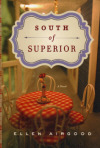South of Superior
Ellen Airgood’s debut novel South of Superior is categorized first under “self-realization in women” and secondly under “Michigan Fiction.” Such categories never tell the full story. Certainly there is a female main character, but she is for much of the book unsympathetic and certainly not a superwoman, and the novel’s delight is in the realism of all the vividly portrayed characters and of Michigan life in a place like Grand Marais, here renamed McAllaster. All Michiganders (not just women) should relish this book for the reliving of this state’s recognizable features and lifestyles.
Madeleine Stone receives a letter from Gladys (the lover of Madeleine’s grandfather, Joe Stone) asking her if she would be interested in helping take care of Gladys’ ailing sister Arbutus. This care would involve Madeleine’s moving from Chicago to McAllaster, a move that would bring back memories of how her grandfather abandoned her as a child after her mother left town. Madeleine still feels bitter especially now after her beloved adopted mother Emmy’s death. Remembering Emmy’s struggles to raise her, Madeleine has no love for Gladys, but she is also curious about her grandfather’s motives and eager for any information about her mother. These facts get revealed eventually, but much of the success of this novel has to do with Airgood’s descriptions of what it is like to live in a small town on the shore of Lake Superior.
Madeleine’s first views of the town are from a bluff:
Even in the driving rain the lake glittered and shone with movement, with the mystery of its whole huge self. It dawned on her that everyone’s cautions had been correct, even if for the wrong reasons. This was a foreign, otherworldly place, complete with magic and perils and tests.
The beauty of the place is quickly mingled with the reality. Gladys takes back her groceries to the store unopened when she finds that the grocers are not allowing credit to their poorer customers. Gladys also refuses to pay for the groceries to these nonresident, more contemporarily practical and ruthless grocers. Then a five-year-old disappears, and when he is found, his very young mother leaves him off at various homes while she works in a bar. Two elderly people are competing with the grocers with their fresh fish and other fresh produce like berries and are threatened by the authorities for living on land not their own. In other words, this is a book about the people of the place as much as about Madeleine and her problems.
The hardscrabble life, the fact that you cannot make much money in such a place, is what Airgood shows best—the philosophy one must have to choose to live there. Mary, the novel’s elderly sage, tells Madeleine:
It ain’t everybody who can live here. You’ll live poor. Like a farmer plowing old, stony ground. You’ll never have much of nothing. Except troubles. They’ll come, and they’ll be hard to fix…If you want to have things your way, the way you want them, you don’t want to stay here. That’s not how it is. But if you can accept the way things are—well, then.”
Then there’s the truth about small towns:
McAllaster was a kind of tribe. This wasn’t cozy, or nice. She sensed that it was an equation, that membership would exact a price: the loss of privacy, anonymity, certain freedoms she’d taken for granted in Chicago, maybe the right to selfishness. Everybody in this tribe didn’t love each other. They disagreed and gossiped and argued; they laid traps for each other and rejoiced when the trap was sprung; they relished placing blame wherever it would stick and took pleasure in one another’s mistakes. But when there was trouble, there was help.
Michigan countryside is real with its “scattered cabins and camps too lonesome and poor to be quaint, old trailers surrounded by broken-down cars and trucks, discarded toilets and cast-off woodstoves, black plastic garbage bags stuffed with God knew what.” But also the people are real, actually inspired by real people listed in the back: “an overabundance of human frailty. No heroes or villains, exactly. Just people who’d done what they’d done, too late to change any of it, and in the end that wasn’t the worst news in the world.”
Yes, Madeleine finds herself changing her attitude, and the formula of finding love is also there, though not emphasized. Her love interest has his problems, which are very real, such as struggling to stay afloat and becoming too quickly angry. Gladys’s and Madeleine’s prickly natures may make other characters sweeter, but nothing here is sentimentalized, and all the characters are vivid, unforgettable.





